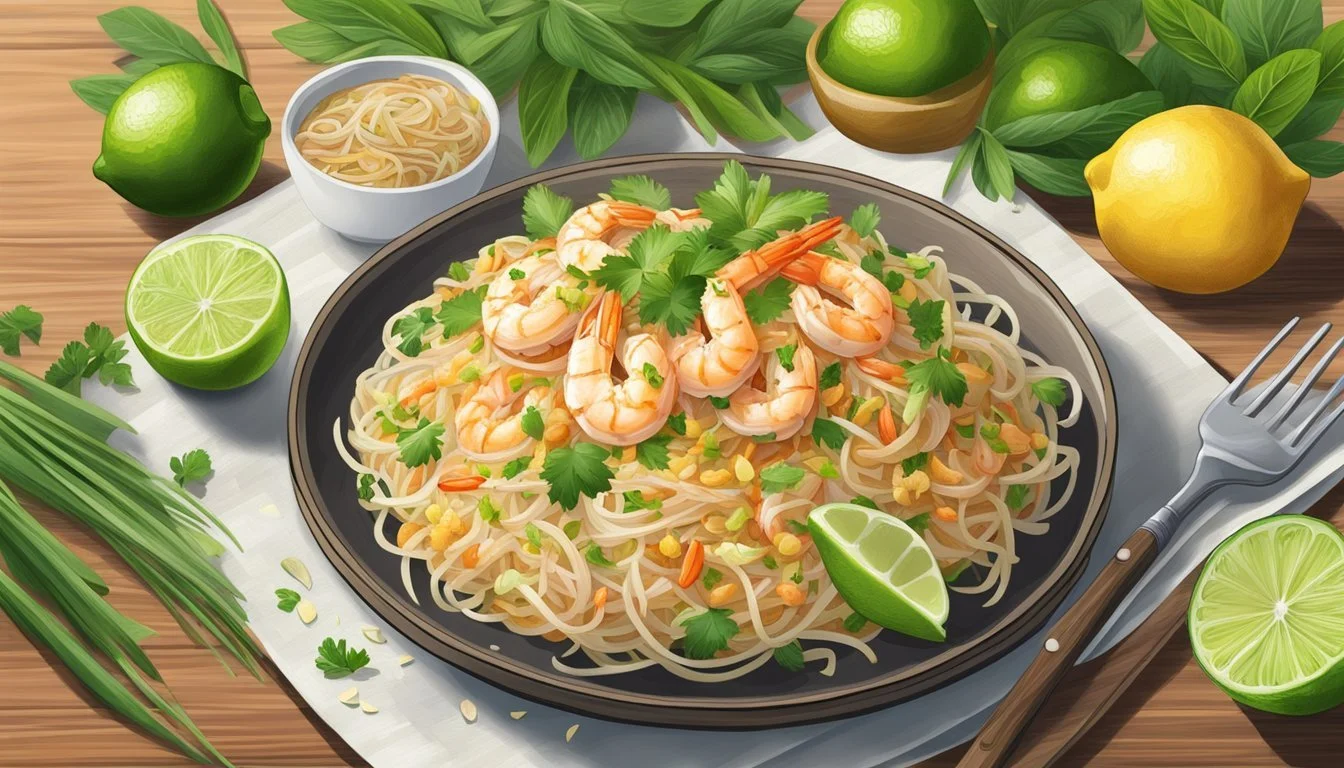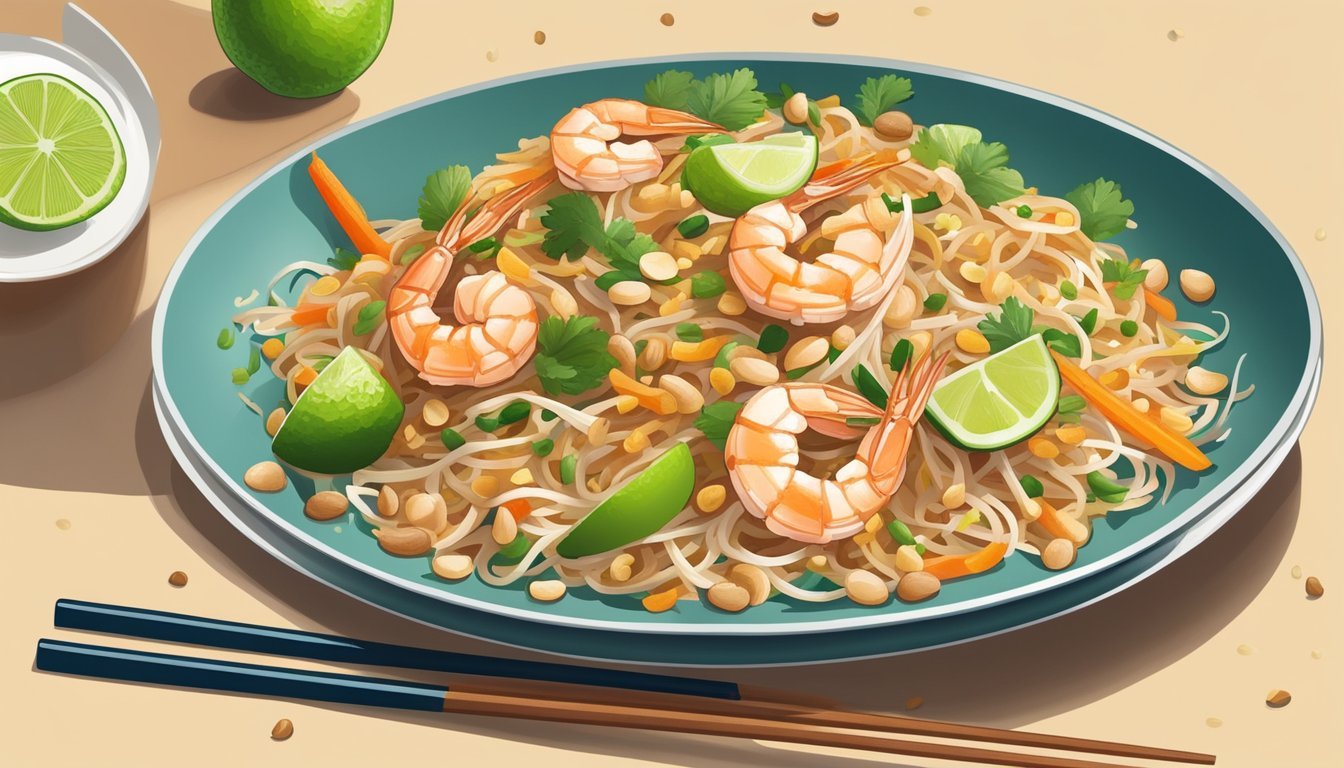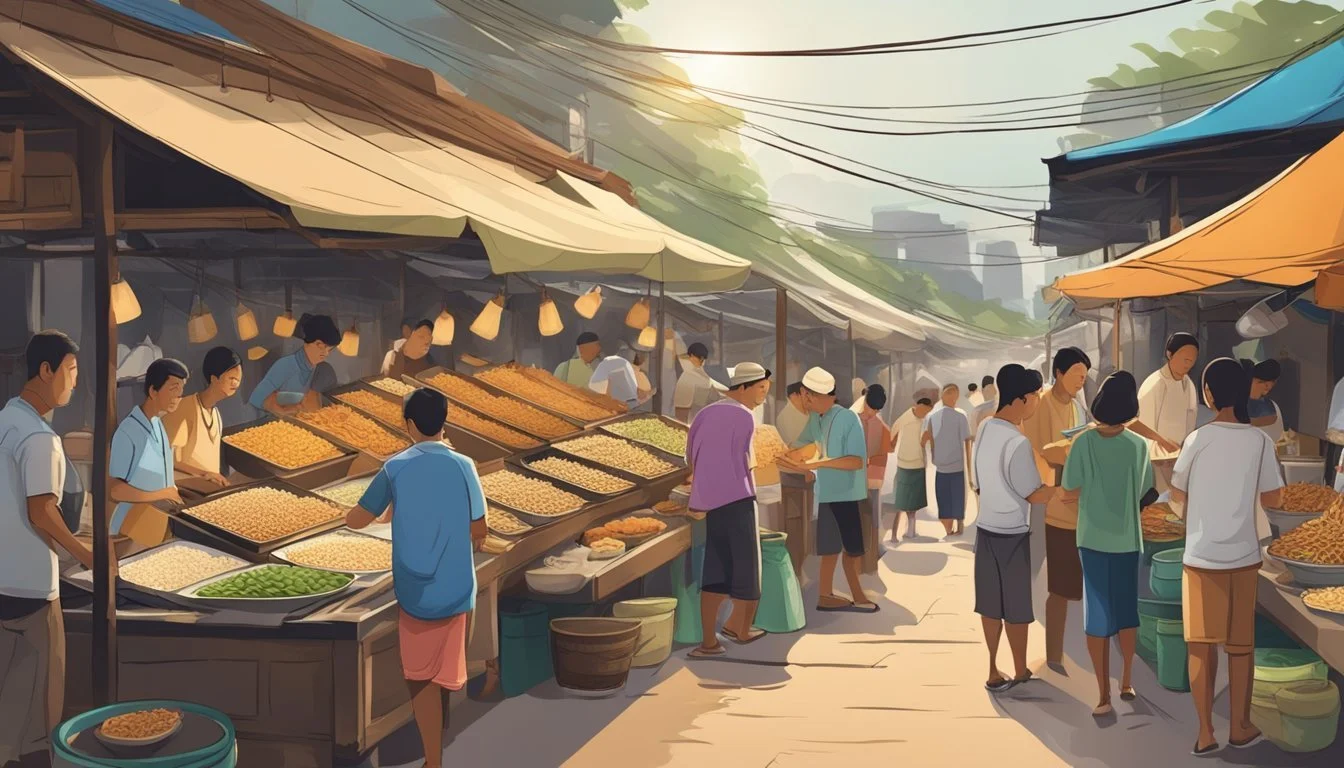How Long Does Gluten-Free Shrimp Pad Thai Last?
Shelf Life and Storage Tips
Gluten-free shrimp pad thai is a beloved dish hailing from Thailand, combining the savory flavors of tamarind, fish sauce, and fresh shrimp. Renowned for its vibrant taste, this dish easily finds a place in any meal plan. When stored in an airtight container in the refrigerator, gluten-free shrimp pad thai can last for up to 3-4 days.
The unique textures and flavors of this Asian food remain intact when properly stored, making it a convenient option for meal prep enthusiasts. Ensure it's cooled quickly and stored correctly to maintain its taste and quality. For an even longer shelf life, freezing can extend its usability for up to 2 months, although the texture of the noodles may change upon reheating.
For those who cherish the authentic taste of gluten-free pad thai, knowing its shelf life aids in meal planning and reduces food waste. Always use fresh shrimp and high-quality ingredients to enjoy the best results.
What Is Gluten-Free Shrimp Pad Thai?
Gluten-Free Shrimp Pad Thai is a popular Thai dish, adapted to be suitable for individuals with gluten sensitivities.
It primarily features rice noodles, which are naturally gluten-free. These noodles absorb the flavors of the sauce and ingredients beautifully.
The dish includes shrimp, which adds a rich, seafood flavor and protein to the meal. The shrimp is often cleaned, deveined, and briefly stir-fried until tender.
Central to the dish is the Pad Thai sauce, typically made from a combination of tamarind paste, gluten-free fish sauce, and other seasonings. Tamari or gluten-free soy sauce is commonly used to ensure the dish remains gluten-free.
Other ingredients like vegetables and eggs can enhance the flavor and nutritional value. Commonly used vegetables include bell peppers, carrots, and bok choy.
Pad Thai takes careful preparation. Starting with heating oil in a wok or frying pan, then sautéing vegetables, followed by cooking the shrimp. The noodles are cooked separately and tossed with the ingredients and sauce.
Here is a simple breakdown of typical ingredients used in Gluten-Free Pad Thai:
Rice noodles
Shrimp
Gluten-free fish sauce
Tamari or gluten-free soy sauce
Tamarind paste
Coconut sugar (optional for sweetness)
Vegetables (bell pepper, carrot, bok choy, etc.)
Eggs (often added for extra texture and flavor)
This dish combines the authentic flavors of traditional Pad Thai with modifications to make it gluten-free. It is a delicious meal option for those adhering to a gluten-free diet.
Ingredients and Substitutions
Rice Noodles: The base of gluten-free Pad Thai, rice noodles are essential. Look for ones labeled gluten-free to ensure they meet dietary restrictions.
Shrimp: Fresh or frozen shrimp work well. If you're vegetarian or vegan, tofu is an excellent substitute. For meat-eaters, chicken can be used instead.
Oil: Use a neutral oil like vegetable or canola oil for cooking.
Tamarind Paste: Provides the distinct tangy flavor. If unavailable, a mix of lime juice and brown sugar can serve as a substitute.
Fish Sauce: Essential for authentic flavor. Ensure it is gluten-free. Coconut aminos can be used as a substitute for a soy-free option.
Gluten-Free Soy Sauce: Adds a salty depth to the dish. Tamari can also be used as a gluten-free option.
Garlic: Adds aromatic richness. Fresh garlic is recommended, but garlic powder can be used in a pinch.
Egg: Adds protein and texture. For vegan versions, omit the egg or use a scrambled tofu replacement.
Peanuts: Crushed peanuts add crunch. Substitute with sunflower seeds if there are nut allergies.
Bean Sprouts: Adds freshness and crunch. Substitutes include shredded cabbage or other crisp vegetables.
Green Onions and Cilantro: Fresh herbs that enhance flavor. These can be omitted or replaced with parsley if preferred.
Make the dish your own with these ingredients but remember that authenticity lies in the balance of flavors. Adjust quantities based on preference and dietary needs.
Preparing Gluten-Free Shrimp Pad Thai
Preparing gluten-free shrimp pad Thai involves using the right cooking techniques, making a flavorful sauce, and handling shrimp properly. Each step ensures the dish is tasty and free from gluten.
Cooking Techniques
Use a wok or large skillet for stir-frying. Heat vegetable oil over medium heat. Begin with garlic and sauté for 30 seconds for aroma. Add red pepper flakes for some heat.
Incorporate vegetables like bell peppers and carrots. Stir-fry until slightly tender. Push the ingredients to one side and add more oil if needed. This creates space for shrimp and eggs, ensuring even cooking.
Cook the shrimp until they turn pink and plump. Then crack an egg into the pan and scramble it quickly. Finally, add the soaked gluten-free Pad Thai noodles and toss everything together.
Sauce Preparation
The sauce defines the dish's flavor. In a small bowl, whisk together key ingredients: tamari (gluten-free soy sauce), tamarind paste, gluten-free fish sauce, and coconut sugar. This combination provides a perfect blend of sweet, salty, and tangy flavors.
Add lime juice for acidity and balance. Adjust the quantity based on your taste preference. Ensure the sauce is thoroughly mixed before adding it to the noodles.
While stir-frying, add the sauce gradually. This allows the noodles to absorb it completely, coating each ingredient evenly. Toss well to integrate all the flavors.
Handling Shrimp
Fresh or frozen shrimp can be used. If frozen, thaw them in cold water. Ensure the shrimp are deveined and cleaned.
In the wok, cook the shrimp in hot oil until they turn pink and opaque. This should take about 5-6 minutes. Overcooking can make them tough, so remove immediately once done.
After removing the shrimp, add them back to the dish with the sauce and noodles. Toss everything together to ensure the shrimp are well-coated and heated through.
By following these steps, gluten-free shrimp pad Thai can be both delicious and safe for gluten-intolerant individuals.
Tips for Making the Perfect Gluten-Free Shrimp Pad Thai
1. Use Fresh Shrimp: Fresh shrimp ensures the best texture and flavor. Clean them well and pat dry before cooking to avoid excess moisture in the skillet.
2. Right Type of Noodles: Opt for gluten-free rice noodles. Soak them in warm water until they soften. Do not overcook them to prevent a mushy texture.
3. Balance Sweet and Spicy: Combine tamarind paste, gluten-free soy sauce, gluten-free fish sauce, coconut sugar, and chili powder. Adjust the quantities to suit your taste for a balanced sweet and spicy flavor.
4. High Heat Stir-Fry: Use a large nonstick skillet or wok over high heat. This method cooks the ingredients evenly and prevents sticking.
5. Oil Management: Use a small amount of oil, adding more as needed. Too much oil can make the dish greasy, while too little can cause sticking.
6. Perfectly Cooked Eggs: Push the ingredients to one side of the pan and quickly scramble the eggs in the open space, then mix them with the rest of the ingredients to distribute evenly.
7. Protein Addition: Besides shrimp, consider adding tofu or chicken to increase the protein content. Cook these proteins thoroughly before adding other ingredients.
8. Veggie Crunch: Thinly sliced bell peppers, carrots, or bean sprouts can add a nice crunch. Stir-fry the vegetables on high heat for a minute or two.
9. Quick Assembly: Have all ingredients prepped and near the stovetop. This keeps the cooking process smooth and prevents overcooking.
10. Garnish for Freshness: Finish with fresh cilantro, lime wedges, and chopped peanuts for a burst of flavor and texture.
Proper Storage
Effective storage is crucial to maintain the quality and safety of gluten-free shrimp Pad Thai. Here, you'll learn the best methods for short-term storage, long-term storage, and the most effective ways to reheat the dish.
Short-Term Storage
When planning to consume leftover shrimp Pad Thai within a few days, short-term storage in the fridge is ideal. Use an airtight container to minimize exposure to air and moisture. Store the dish at a temperature below 40°F (4°C) to preserve freshness and prevent bacterial growth.
Ensure the Pad Thai cools to room temperature before refrigeration, as placing hot food directly in the fridge can raise its internal temperature. To avoid soggy noodles, place paper towels over the noodles to absorb excess moisture.
Long-Term Storage
For extended storage, freezing shrimp Pad Thai is an effective option. Divide the dish into individual servings and place each in a freezer-safe container or zip-lock bag. Label the containers with the date to keep track of shelf life. Frozen Pad Thai maintains its quality for up to 2-3 months.
Avoid storing the dish with scrambled eggs, as they do not freeze well. Remove any garnishes such as peanuts or fresh herbs before freezing. Thaw the Pad Thai in the fridge overnight for the best results before reheating.
Reheating Methods
Reheating shrimp Pad Thai correctly helps in retaining its flavor and texture. Here are three methods:
Microwave: Place the Pad Thai in a microwave-safe dish, cover it with a damp paper towel to prevent drying out, and heat on medium power for 1-2 minutes. Stir halfway through to ensure even heating.
Stovetop: Reheat in a frying pan over medium heat with a splash of water or oil. Stir frequently until heated thoroughly. This method helps in preserving the texture of the noodles and shrimp.
Oven: Preheat the oven to 350°F (175°C). Spread the Pad Thai in an oven-safe dish, cover with aluminum foil, and heat for about 15 minutes. Stir halfway through to ensure even heating. This method works well for larger portions.
Each reheating method has its advantages, so choose based on convenience and the amount of Pad Thai.
Shelf Life of Gluten-Free Shrimp Pad Thai
The shelf life of gluten-free shrimp Pad Thai largely depends on how it's stored.
When kept in the refrigerator at or below 40°F (4°C) in an airtight container, it can last for 3 to 4 days. This storage method ensures the dish stays fresh and prevents bacterial growth.
Key Factors Influencing Shelf Life:
Freshness of Ingredients: Fresher ingredients extend the dish's longevity.
Temperature: Consistent refrigeration at the correct temperature is crucial.
Container: Airtight containers help maintain freshness and prevent contamination.
For longer storage, freezing is an option, although the texture might be affected. To freeze, place the Pad Thai in a freezer-safe container, and it can last for up to 1 to 2 months.
Storage Tips:
Cool Before Storing: Allow the dish to cool to room temperature before refrigerating or freezing.
Portioning: Store in small portions to make reheating easier and to reduce the risk of contamination.
Labeling: Label containers with the date of storage to keep track of freshness.
Following these guidelines can help ensure that gluten-free shrimp Pad Thai maintains its quality and safety for consumption.
Health and Dietary Considerations
Gluten-Free: For those with celiac disease or gluten sensitivity, ensuring shrimp Pad Thai is gluten-free is crucial. Use ingredients like rice noodles, gluten-free tamari or soy sauce alternatives, and be mindful of cross-contamination in preparation.
Sodium: Traditional Pad Thai sauces can be high in sodium due to ingredients like fish sauce and tamari. Using low-sodium versions or reducing the amount can help manage sodium intake.
Dairy-Free and Soy-Free: This dish can easily be made dairy-free and soy-free by choosing appropriate ingredients. For those with soy allergies, alternatives like coconut aminos can be used instead of soy sauce.
Allergies: Always check labels for common allergens. This includes fish sauce (fish allergy), peanut garnishes, and potential cross-contamination with gluten.
Sugars: The choice between coconut sugar and brown sugar can affect the glycemic index of the dish. Coconut sugar has a lower glycemic index compared to brown sugar, offering a slightly healthier alternative.
Ingredients List:
Rice noodles
Fresh vegetables (e.g., bell peppers, carrots)
Gluten-free alternatives (tamari, soy sauce substitutes)
Protein options (shrimp, tofu)
Sweeteners (coconut sugar or brown sugar depending on preference)
This ensures the meal caters to diverse dietary needs while remaining nutrient-dense and flavorful. Proper ingredient selection and preparation are key to a healthy and enjoyable gluten-free shrimp Pad Thai.
Variations of Shrimp Pad Thai
Shrimp Pad Thai is a versatile dish that allows for numerous variations to suit different dietary preferences and tastes.
Chicken Pad Thai
For those who prefer chicken, substitute the shrimp with sliced chicken breast. Cook the chicken until it is no longer pink, then add it to the noodles and vegetables. This version provides a different protein source, giving the dish a unique flavor.
Tofu Pad Thai
For a vegetarian or vegan option, replace the shrimp with firm tofu. Cut the tofu into cubes and cook until golden on all sides. This option is rich in protein and suitable for both vegetarians and vegans.
Vegetable Pad Thai
Omit the shrimp altogether and load the dish with a variety of vegetables. Bell peppers, carrots, bean sprouts, and broccoli are great choices. This makes for a nutrient-dense and colorful dish that is perfect for those avoiding animal products.
Vegan Pad Thai
Similar to the vegetable version, but ensure all sauces used are vegan-friendly. Substitute fish sauce with soy sauce or tamari and use agave syrup in place of honey. This ensures the dish is entirely free from animal products.
Mixed Protein Pad Thai
Combine shrimp, chicken, and tofu for a rich, diverse bite. This variation offers multiple textures and a satisfying blend of flavors that caters to those wanting a bit more complexity in their meal.
Spicy Pad Thai
Enhance any variation by adding extra chili powder or fresh chopped chilies. This provides a fiery kick, making the dish suitable for those who enjoy spicier food. Adjust the spice level according to personal preference.
Each of these variations allows for creative twists on the traditional shrimp pad thai, making it adaptable to a wide range of dietary needs and tastes.
Serving Suggestions
A well-presented Gluten-Free Shrimp Pad Thai can elevate the dining experience. Complementing it with the right accompaniments enhances the flavor and ensures a memorable meal.
Presentation
Using attractive presentation techniques can make your dish more appealing. Serve Gluten-Free Shrimp Pad Thai on a large, flat plate or shallow bowl to allow the vibrant colors of the dish to stand out. Garnish the top with a generous handful of chopped peanuts for added crunch.
Place a few lime wedges on the side to allow diners to squeeze fresh juice over their portion, enhancing the flavor. Sprinkle some fresh cilantro and green onions on top for a burst of color and fresh taste. If you enjoy a touch of creaminess, consider adding a small dollop of peanut butter on the side.
Accompaniments
Pairing Gluten-Free Shrimp Pad Thai with the right accompaniments can elevate the dish. A fresh vegetable salad with a light dressing complements the strong flavors of Pad Thai.
Prepare a plate of steamed or pickled vegetables as a side to add texture and contrast. For those who appreciate a bit of heat, offer a small dish of sliced chili peppers or chili sauce. If you prefer a heartier meal, a side of steamed jasmine rice provides a neutral base that balances the dish's rich flavors.
Using these suggestions ensures each element complements the meal, offering a varied and delightful dining experience.
Cultural Significance of Pad Thai
Pad Thai holds a special place in Thailand's culinary landscape. Originating in the 1930s and 1940s, this dish was introduced as part of a national campaign to modernize Thailand and emphasize its independence. It quickly became a beloved element of Thai food culture.
Commonly found in street food markets across Thailand, Pad Thai exemplifies the essence of urban Thai cuisine. Vendors whip up plates of this iconic dish, delighting both locals and tourists with its balanced flavors.
As a quintessential world cuisine item, Pad Thai has earned its place on menus globally. This is a testament to its widespread appeal, transcending cultural and geographical boundaries.
Pad Thai is celebrated for its harmonious blend of flavors and textures. Stir-fried rice noodles serve as the base, combined with ingredients like shrimp, tofu, bean sprouts, and peanuts. The unique sweetness and sourness from tamarind paste and fish sauce highlight Asian food culture's complexity.
The dish reflects Thailand’s history and innovation within its culinary practices. It signifies both the traditional and contemporary influences in Thai cooking, making it an enduring symbol of the country's rich heritage.
Pad Thai’s versatility and adaptability further reinforce its cultural importance. Whether enjoyed at a bustling night market or a high-end restaurant, it remains a favorite among many. The dish's cultural significance lies not only in its ingredients but also in its ability to represent Thailand's vibrant essence to the world.
Online Resources and Communities
For those curious about how long gluten-free shrimp pad Thai lasts, numerous online resources and communities are invaluable.
Pinterest is a popular platform where users share detailed recipes, longevity tips, and storage hacks for homemade dishes. Searching for "gluten-free shrimp pad Thai" yields a plethora of pins with user reviews and comments.
Instagram hosts many food bloggers and chefs specializing in gluten-free Thai cuisine. Following hashtags like #GlutenFreePadThai or #ThaiFoodEnthusiasts can provide insights and visual tips on making and storing this dish.
Facebook groups such as "Gluten-Free Recipe Sharing" or "Thai Food Enthusiasts" offer a collaborative environment. Members exchange experiences, recipes, and tips on the longevity of cooked meals, including shrimp pad Thai. Engaging in these groups can provide personalized advice and real-time feedback.
Recipe sharing websites often come with review sections where users discuss the shelf life of dishes. Platforms such as AllRecipes or Food.com can be searched for gluten-free shrimp pad Thai recipes with user comments that can provide practical advice on storage durations.
Joining these communities not only enhances cooking knowledge but also helps in understanding the best practices for storing and consuming gluten-free shrimp pad Thai.












